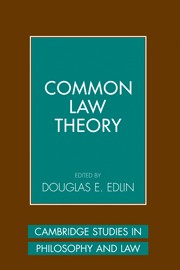5 - Reasoned Decisions and Legal Theory
Published online by Cambridge University Press: 17 September 2009
Summary
In dealing with the antinomy of reason and fiat, the main effort of the various schools of legal philosophy has been to obliterate one of its branches.
Lon L. Fuller[T]he historical study of legal institutions may have more to offer to … [the] … solution [of the problems of legal theory] than has yet been appreciated.
A. W. Brian SimpsonThe common law tradition claims not only that the law is reason but also that the reason of the law is morally good. Judges' reasons for decision, their judgments, are considered within this tradition to be evidence for this claim, for the way in which the common law “works itself pure.” Philosophers of law who work in common law jurisdictions have taken one of three approaches to this claim.
First, there are philosophers who have tried to make sense of the common law through an argument that in attending to the way that judges interpret the law, we will not only best understand law but also discern the connection between law and morality. We will call such philosophers, without any pejorative intent, common law romantics. Most notable among them is Ronald Dworkin.
Second, philosophers have argued that the common law is a mess – in Jeremy Bentham's words, a “shapeless heap of odds and ends.” Such a mess, Bentham argued, leads to uncertainty about the law that not only is contrary to the demands of utility but permits “Judge & Co.” to arrogate power that properly belongs to the legislature.
- Type
- Chapter
- Information
- Common Law Theory , pp. 134 - 168Publisher: Cambridge University PressPrint publication year: 2007
- 6
- Cited by



